Martech Stack Audit and Optimization: When and How To
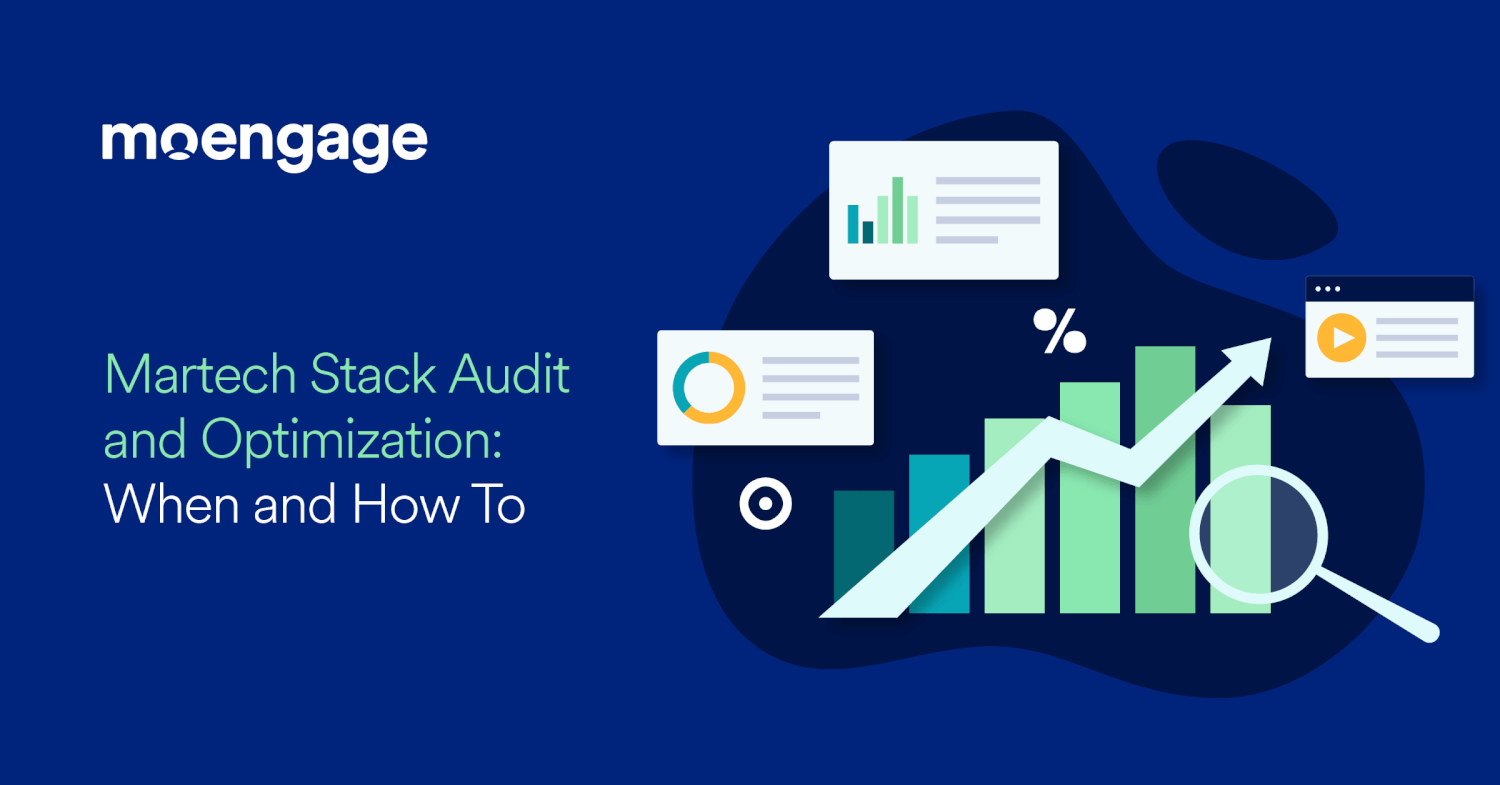
Reading Time: 12 minutes
If you’re a marketer, chances are you regularly work with a predefined grouping of marketing solutions to help you do your job.
These tools are there to make your life easier and your work more efficient. However, over time, the tools required to achieve the desired results can grow and change—sometimes for the better, and sometimes for the worse.
This is where martech stack optimization comes in, and typically, it begins with a martech stack audit, which is exactly what we will cover in this article. Here, we’ll dig into what makes up a solid martech stack, the importance of investing in future-ready software, the signs it’s time to optimize featuring insights from industry expert Meri Williams, and how to run a martech audit.
Let’s get to it.
What is a Martech Stack?
A martech stack—or marketing technology stack—is the collection of software and tools that, when compiled, make up the cohesive solution used by an individual marketing entity to perform the processes needed to track and measure the customer journey and meet their specific goals for growth.
Although thousands of martech applications are available, most martech stacks consist of a few core platforms. This can include tools for email marketing, social media management, analytics, customer relationship management, customer engagement platforms, and more.
What are the key components of a martech stack?
A standard B2C martech stack foundation would include the following primary components:
- Content Management System (or CMS): This is what the company’s website is built with and houses most of the company’s digital content.
- Customer Data Platform (or CDP): Customer data platforms enable brands to collect customer data from multiple sources and collate all data about one customer together to create a unified customer profile. The CDP then combines these data points to build out a unified customer profile. Any of the platforms connected can then access this profile.
- Customer Relationship Management system (or CRM): This database contains valuable customer information and helps marketing, sales, and customer service teams create customer profiles, automate customer service efforts, collect customer data, and examine trends.
- Customer Engagement Platform (or CEP): This tool ingests customer data and allows brands to optimize the customer lifecycle by segmenting and personalizing communication across channels, analyzing and predicting customer preferences, and aiding in real-time engagement strategies to create relevant and timely customer experiences.
Then, there are other critical components that may or may not be included as features within the foundational software but that teams will need in order to execute effective campaigns. Those capabilities include:
- Email Marketing
- Social Media Marketing and Management
- Online and Offline Advertising
- Analytics
- SEO
What does a good Martech Stack look like?
As mentioned, it is a best practice to have software applications available for marketers to achieve their goals. For the best results, these solutions should consist of modern marketing technologies and tools that are agile, scalable, and innovative.
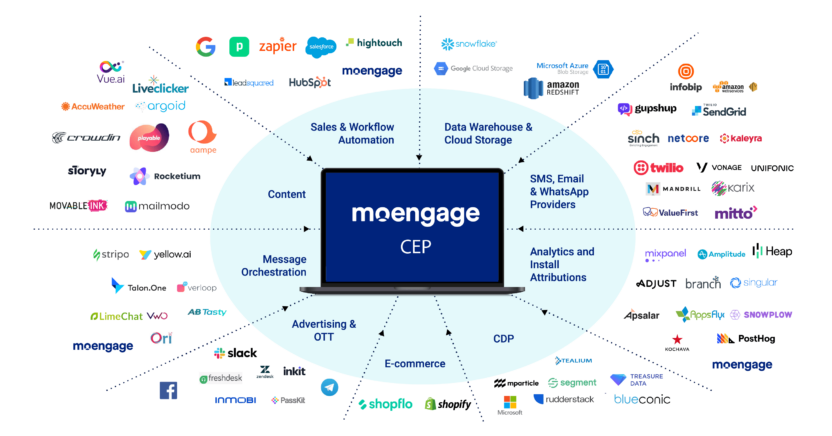
Having a more modern martech system opens up many valuable opportunities for businesses to connect with their target audience. Businesses can improve their marketing efforts, personalize customer experiences, secure customer data, and run operations more efficiently, resulting in increased productivity and growth.
We’ve seen the exact growth with most clients that have taken the same modernization approach. Skroutz, the only marketplace that has beaten Amazon in Greece, uses a modern customer engagement platform to engage with more than 8 million unique web & app visitors monthly.
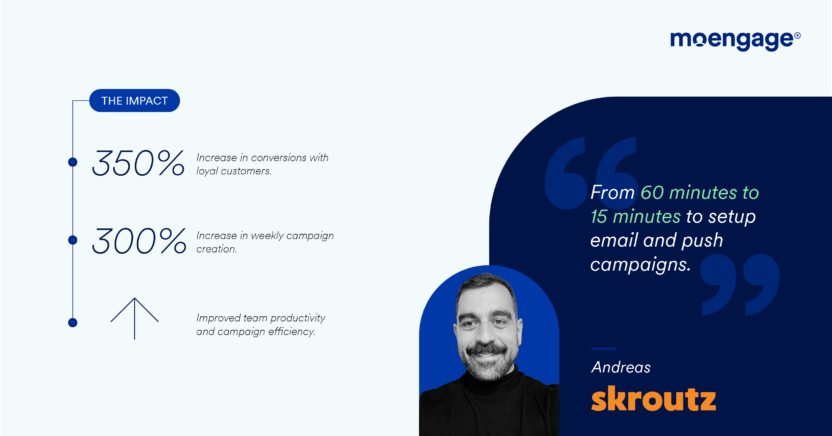
By creating a cohesive martech stack, businesses can better execute and track their campaigns, leading to more informed decision-making and ultimately improved ROI.
But what if your marketing tech stack doesn’t look like the one above? Or what if you don’t feel like your current setup is enabling you and your team to work efficiently, effectively, and successfully?
In the next section, we’ll look at performing martech stack optimization based on recommendations from renowned industry expert Meri Williams, and how to identify the signs it’s time for a change.
5 Signs to Update Your Marketing Tech Stack Now
As noted, Meri Williams is a seasoned technology executive with experience at Pleo, Monzo, MOO, Marks & Spencer, and Procter & Gamble, as well as a published author, international speaker, and chair (co-curator & host) of The Lead Developer conference series.
She’s identified five key indicators that your martech stack may not be future-ready and the key reasons for optimization.
1. Outdated Technology
Many businesses, particularly as they expand into large enterprises, often find themselves grappling with outdated technology and a heavy reliance on legacy systems, some of which are so old that they could be considered vintage. Usually, these old systems function on-premise rather than in the cloud, which presents considerable difficulties in keeping up with current trends and technologies. Their scalability and potential for future growth are limited.
Marks & Spencer spent over a million pounds to commission and build a new website, which immediately reduced conversion rates by half when it went live. It was a difficult time for the company because, while they had made a significant investment in a new website and stack, they had done so in a manner that took 5 years to complete. By the time the new system went live, it was already outdated. And even at the point of go live, it had been such a long road that it was already exceedingly difficult to keep up with the demands and needs of the business.
The key message that Meri Williams pointed out on this is that…
It’s absolutely worth considering how your tech team is going to react, how your IT colleagues are going to react, and making sure that you choose more modern tech that is going to be easier to scale and easier to develop into the new capabilities that are needed as your business grows and hopefully scales.”
In the marketing realm, this message illustrates the importance of investing in flexible marketing technology that can be implemented in a timely manner and updated as needed by the marketing practitioners themselves to avoid costly delays and disruptions to business operations.
2. Inefficient Workflow
If there is a significant amount of duplication of effort across key tools, a lack of automation, and challenges in measuring the return on investment, it is possible that your workflows may be inefficient.
Pleo, Europe’s leading business spending platform, had acquired a variety of tools that teams later discovered were not compatible with each other. These tools lacked the ability to automate key processes, and the business had difficulty measuring return on investment.
Monzo, one of the pioneers among the new app-based challenger banks in the UK, initially focused on building their own tools in-house without considering the bigger picture of workflows and end-to-end processes. This approach posed some challenges for them in the early days because they suffered from inefficiencies that wouldn’t have existed if they had considered purchasing more agile software.
Proctor and Gamble went through a phase where they kept trying to change the way people worked by changing the technology they used, rather than first realizing that they needed to, even if it was in a manual way, change the process and get people used to the new process before they enshrined it in the technology.
There’s a saying in tech and IT circles that if you try to change processes by just changing technology, you’ll often fail. You must also be realistic about how frequently your processes and workflows will change and adjust accordingly.”
Choosing martech tools that are flexible and reliable at scale is essential. Marketing tools should have multiple options for customizing workflows to fit your specific needs. This is a necessary strategic decision that you must make within your business when deciding on tooling: whether you will put in the effort to adjust the way you work to the way the tool works or whether you will find something flexible enough to adapt to the way you want to work.
Culture also influences internal processes and investment decisions. Whether you iterate frequently, resulting in constant changes to your processes and workflows, or you don’t optimize very often, leading to infrequent changes but dated processes and practices, it is a strategic decision how closely you match the process to the tool, or the tools to the process.
3. Data Silos
This is one of the most frequent problems businesses face within their organizations, as communication silos often lead to disconnections in the customer journey.
Disconnected data sources and the inability to create a unified view of the customer prevent you from obtaining consistent insights, which then causes challenges in personalizing marketing campaigns, delivering targeted messaging, and ensuring that the product adapts to the customer and is personalized to the individual rather than just one of a few personas.
Overcoming this requires more than just having the tools to allow easy data export and pulling data into a different system or data platform. It also requires an understanding of the schemas and data structures.
We hear a lot about data lakes these days. If you’ve ever come across the term data lake (and wondered what it means), the simplest way to describe it, according to Meri, is a method of gathering a bunch of unstructured data into a single location, which can then be organized and structured as needed.
Think of it as this big lake of data that you then use pipes to pull water out into the right structures and shapes that you need.”
When looking for martech tools to optimize your stack, it’s important to consider whether the tool can efficiently import warehouse data and data from various sources or seamlessly export data into your existing data infrastructure and architecture.
Really test the vendors’ platforms on this to ensure you aren’t just being sold the dream but that it works as advertised. This will save you from spending half of your time figuring out why one system says something different than another and arguing with your analysts about which numbers are correct rather than discussing what insight you get from those numbers.
Another thing that you can look for is whether there’s really really good analytics in the tools themselves. But again, sometimes the challenge comes when you’ve got multiple data sources, multiple bits of insight that you want to bring together.”
Additionally, it can create a great deal of administrative burden for teams attempting to look into or explain why certain things don’t match or why the insight differs between tools.
So the ideal thing to do is to work very closely with your IT counterparts and, if you have a data team, to ensure that they can get everything they need out and into the analytical tools that you’re using in your organization, whether that’s Tableau, Looker, or any of the other options that exist.
4. Lack of Integration
Another sign is a lack of integration, which is just as common as the issue of data silos. The inability to share data across platforms inevitably necessitates manual work to sync information between systems.
This frequently leads to a lack of real-time information, ultimately leading to decisions being made based on outdated information. It’s difficult to have a comprehensive view when you have multiple platforms, systems, and tools that can’t or don’t communicate with one another.
MOO, one of the world’s fastest-growing print businesses, once faced a significant operational challenge because its product, customer service, and manufacturing platforms were all separate.
It was hard to track an order from when a customer placed it until it was manufactured and delivered, and any necessary customer service was provided. To allow for cross-platform interoperability, the company had to build a system on top of each of the three legacy systems.
If you’re thinking about updating your martech stack, switching platforms, or trying to incorporate customer engagement into your digital transformation, it’s important to choose tools that have well-designed APIs with good documentation.
Marketers should have a deeper understanding of the significance and the role APIs play in the overall tooling process. Without reliable APIs, you’ll be stuck manually handling large files, which can lead to errors if someone forgets or doesn’t follow the correct process consistently.
It’s a domino effect that can greatly affect the entire team regarding time, resources, and financial setbacks.
API just means a standard interface for asking for something and getting it back consistently. So think of an API as being like a menu. You can order off the menu, and you can be reassured that you’re gonna get exactly what you order every time. That’s essentially what an API does. It just gives you a consistent response to whatever you ask for.”
5. Lack of Alignment with Business Goals
Businesses that strategically align their martech stack with their business objectives will maximize the value of the tools they have invested significant resources in. They can enhance their concentration on their target audience, streamline their workflows, and ultimately enhance their operational efficiency and financial success.
Remember that the products you choose and how you approach them should be based on the realities of your business and your customers (i.e., their needs, preferences, and the technologies they use).
This helps guarantee that you are making the correct technology investments and seizing the right opportunities to foster your company’s expansion.
How to Conduct a Martech Stack Audit: 10 Steps
If you recognize these warning signs in the technologies you currently have, it may be a good idea for you to evaluate other options with an martech audit. Take charge of the audit process, engage in open and transparent discussions with key stakeholders, and establish well-defined objectives to ensure that martech tools are in sync with business goals.
Below are ten specific steps to follow when performing a martech stack audit:
1. Define the Purpose of the Audit
- Identify Business Objectives: Clearly outline the business objectives, such as improving customer engagement, streamlining campaign management, or enhancing data-driven decision-making.
- Set Audit Goals: Your goals might include identifying tool inefficiencies, optimizing workflows, or reducing costs. For example, you might aim to move from a fragmented customer engagement architecture to a more unified system like MoEngage.
2. Inventory Your Existing Tools
- List All Tools: Create an inventory that includes tools for customer data management, campaign management, analytics, and integrations.
- Gather Usage Data: Assess how frequently each tool is used, focusing on whether they contribute to your primary objectives, such as managing customer data across touchpoints or automating cross-channel campaigns.
3. Assess Tool Effectiveness
- Evaluate Tool Performance: For each tool, assess its effectiveness in achieving your objectives. Consider if your current tools can optimize campaigns or predict customer actions, as Merlin AI in MoEngage does.
- Measure ROI: Calculate the ROI for each tool by comparing costs against benefits like increased campaign effectiveness or improved customer segmentation.
- Check for Overlaps: Identify tools with overlapping functionalities, such as separate modules for segmentation and audience insights, which might be consolidated into a single platform.
4. Evaluate Integration and Data Flow
- Check Integrations: Assess how well your tools integrate. A robust integration framework is essential, as shown in the example below where data is seamlessly streamed across the stack.
- Examine Data Quality: Ensure data consistency across your stack. Poor data flow can hinder operations, similar to the fragmented data collection and reporting shown in the “Before MoEngage” architecture (below).
- Identify Gaps: Determine if your stack lacks critical functions, such as a unified messaging infrastructure or a recommendation engine that suggests relevant content.
5. Assess Compliance and Security
- Review Compliance: Ensure all tools comply with relevant regulations, especially those handling customer data.
- Check Security Measures: Evaluate the security protocols of each tool, ensuring they meet industry standards, particularly for data management and customer information.
6. Gather Feedback from Stakeholders
- Engage Users: Collect feedback from teams using the tools. Understand pain points, such as the need for agency support or additional modules for personalization.
- Collaborate with IT: Work closely with IT to ensure tools align with the broader strategy and integrate with other systems to streamline operations.
7. Benchmark Against Industry Standards
- Compare with Competitors: Research how competitors use martech stacks and see if they have streamlined their architecture to avoid complexities.
- Stay Updated on Trends: Keep on top of the latest trends, such as AI-driven insights or unified customer data management.
8. Make Data-Driven Decisions
- Analyze Findings: Use your audit findings to decide which tools should be replaced, upgraded, or integrated further. Look for opportunities to consolidate tools or adopt more flexible, future-ready systems.
- Prioritize Actions: Prioritize tools that offer high ROI and align with your strategic goals, like improving cross-channel campaign management or enhancing customer data integration.
9. Develop a Martech Stack Optimization Plan
- Create a Roadmap: Develop a plan for optimizing your martech stack, possibly by transitioning to a unified platform that reduces dependencies on multiple, disparate systems.
- Communicate Changes: Ensure all stakeholders understand the reasons for any changes, and provide training, particularly if new are introduced.
10. Monitor and Review Regularly
- Establish Ongoing Monitoring: Implement continuous monitoring of your martech stack’s performance.
- Adapt to Changes: Be ready to adapt your stack as your business evolves, ensuring it remains efficient and effective, much like the transition from a fragmented architecture to a unified solution.
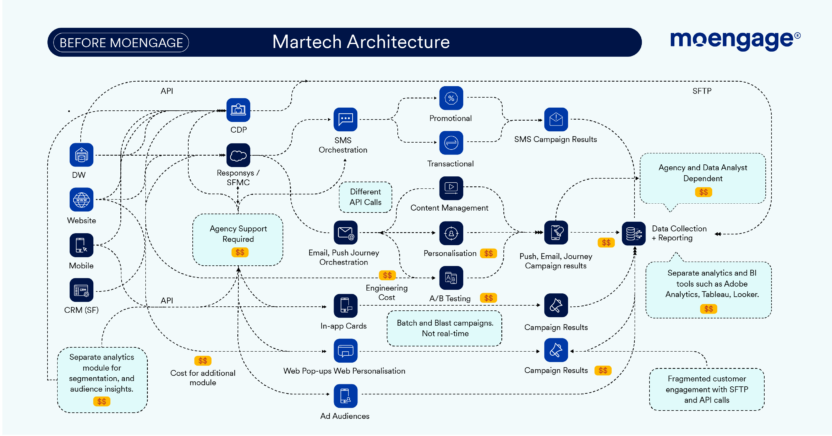
Vs
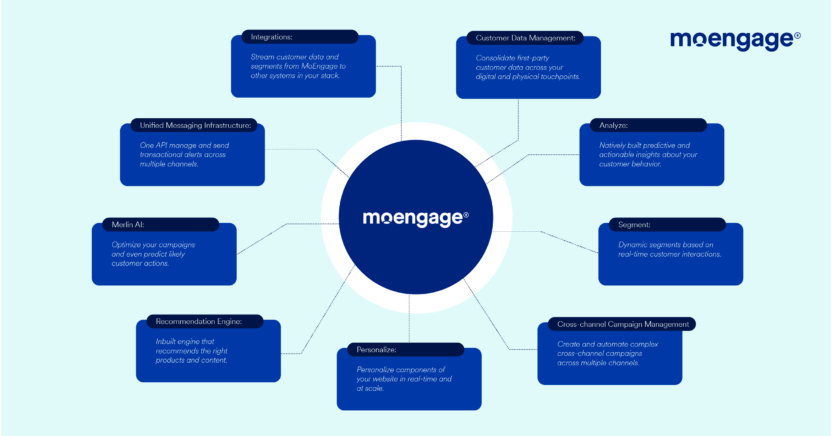
Bear in mind that no matter which approach you choose to enhance your tooling process and capabilities, continuously piling up new applications and data systems on outdated martech is not a sustainable solution.
It is costly, fragmented, and only addresses issues after they arise.
How to Build the Best Martech Stack with MoEngage
Influencing change within an organization is never easy. But at times, it is critical to course-correct when outdated processes, mindsets, or technology get in the way of growth and innovation, ultimately hindering customer satisfaction.
Martech stack optimization and auditing fall into this category of preventative measures that brands can take to ensure the longevity and success of their marketing and customer engagement programs.
If a marketing stack is not continually assessed and optimized, problems that are challenging (and costly) to navigate will arise. This leads to operational debt that can wreak havoc if not addressed before it’s too late, which is why understanding the fundamentals of building and maintaining the best martech stack are key.
If you are facing any of the issues noted in this article and are interested in optimizing your martech stack to include a modern customer engagement solution like MoEngage, get in touch so we can show you just how streamlined, connected, and successful your customer marketing programs can be.















